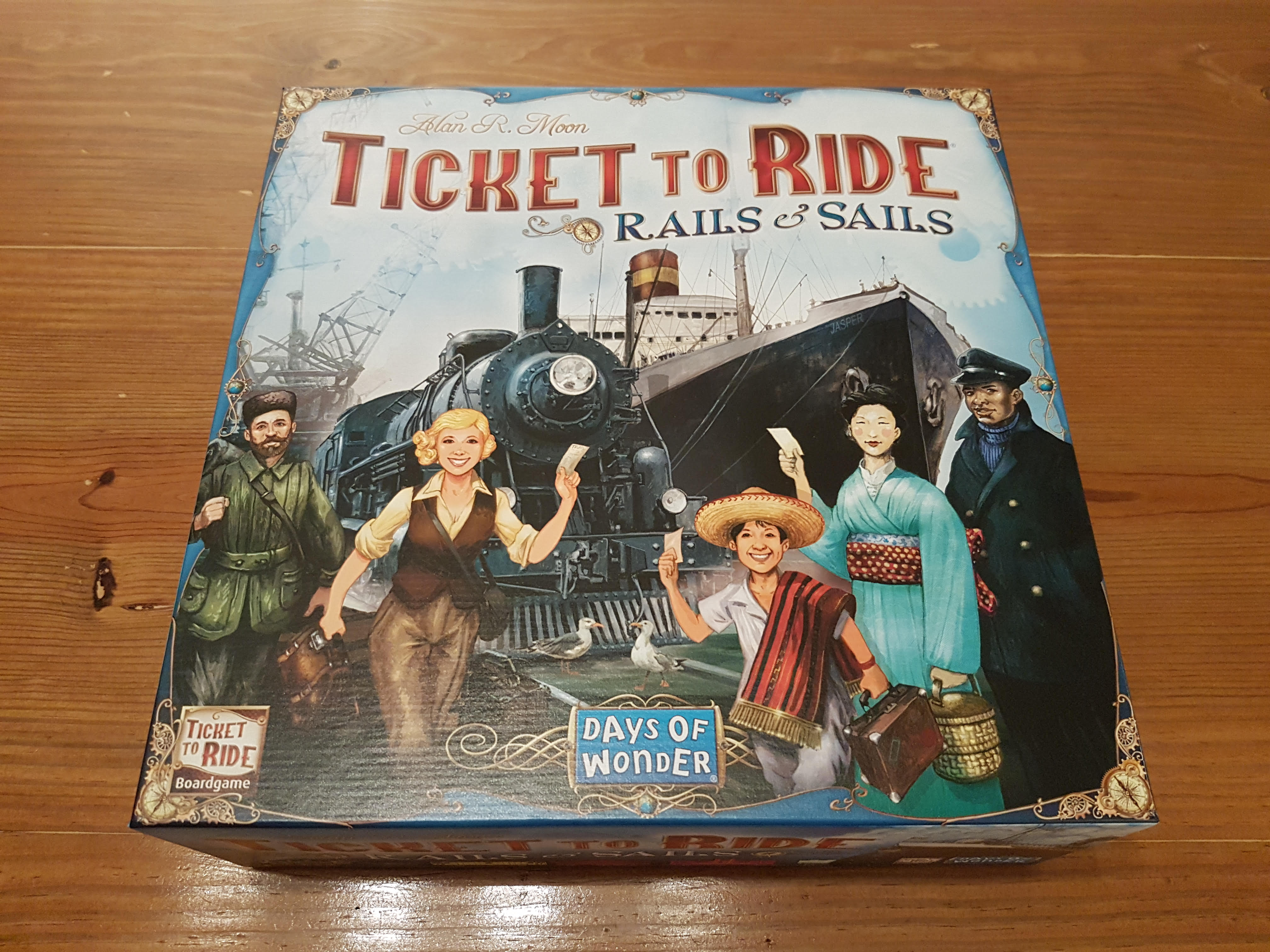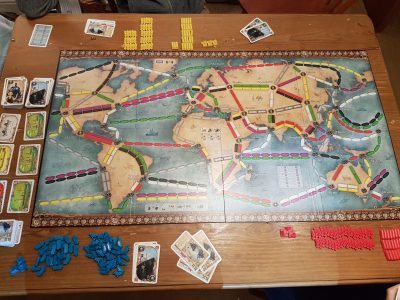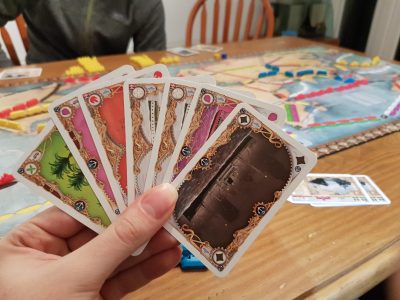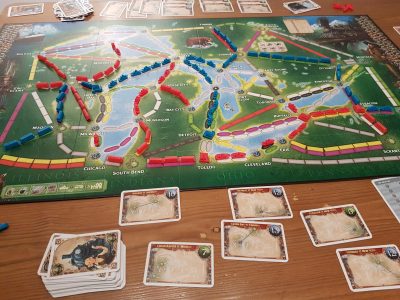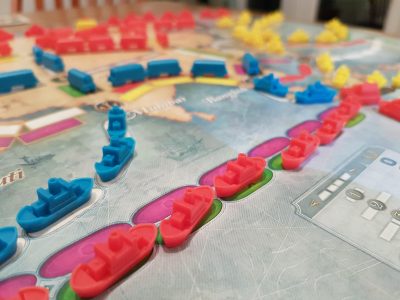Ticket to Ride: Rails & Sails is a travel themed set collection and route building board game from designer Alan R. Moon and publisher Days of Wonder. This is the first game in the series that players will not only be constructing train routes across land but also sail across the oceans and seas. An average game takes a bit longer than a normal Ticket to Ride franchise game, lasting around 1.5 hours. One side of the board, rather than a specific territory, country or even continent features a global map. However, with a both rails and sails to deal with is this a step to far from the iconic gameplay the franchise is known and loved for? Let’s find out!
Though not a direct expansion, as with the map packs, Ticket to Ride: Rails & Sails can be considered above the normal base games. As a result, I’ll aim to comment on the changes this brings to the gameplay of the “standard” variants of the franchise. First and foremost is the biggest change, as the name suggests players will be building routes across both land and water. Unlike, other variants this isn’t just via train-based ferries, players will be building routes with ship pieces.
For your first game, the rules suggest each player starts with 20 trains and 40 ships for World and 23 ships and 27 trains for Great Lakes. However, using World as an example, each player at the start of the game receives 25 trains and 50 ships. It is left up to individual players on what 60 pieces they keep, with some help from their starting destination tickets. While this choice is important it isn’t entirely game defining as a player can choose, instead of a normal action, to swap in-play pieces with those in the box at a cost of 1 point per piece. This isn’t cheap but if it enables a player to finish a route it can easily be worthwhile.
With two types of travel comes two types of travel tickets, renamed from merely train tickets. Two independent draw decks are kept and at the offset of the game 3 of each card type are filled over to form a pool of 6 available cards. Whenever a player draws a travel card they get to choose which draw deck the card is replaced from, so it is entirely possible that no ship cards or no train cards are face up. Players still have the ability to top draw from the draw decks, so it is more limiting in choice than completely stopping the action.
An interesting difference is that ship cards can feature either one or two ships via a smack symbol. Playing these double ship cards, as expected, count as two towards a routes cost, with overpayment allowed. Despite the long shape of the board it doesn’t visually look as crammed with routes as other variants. Therefore, on the surface this inclusion seems an unnecessary one. It isn’t until drawing cards from the six on the table that their use to reduce the overall length of the game becomes apparent.
Two new actions, including the aforementioned piece exchange, become available to players, on top of taking travel cards, claiming a route or drawing destination tickets. The second new action is to build a Harbour. Harbours provide huge potential point swings at the end of the game, with each player starting with three. If a player has a route built to a city with a port symbol, a player can choose to spend two train and two ship cards of matching colour, all including the anchor symbol, to build a harbour there.
Choosing the right city to build in is key as players can gain up to 30 or 40 bonus points, for World and Great Lakes respectively. In both variants these bonus points are based upon how many completed destination tickets a player has into that port city. In a lower player count game hitting the top bonus is more common as you have less chances of others building into your ports and you have the potential of drawing more destination tickets. Timing of harbour placement also presents an interesting choice; do you go early to make sure that someone else cannot build there or late on to know where will get you the most bonus points? I’m still unsure of the best tactic and it does change from one game to another based on the destination ticket that get drawn.
Card hoarders beware Ticket to Ride: Rails & Sails can even be a handful for normal players. Players won’t just be collecting one type and colour of card. For multiple routes players will have to flick between decks. This is in part exasperated by the draw piles only having three cards of each type being face up to choose from. Due to this, players will often top draw from the decks in hope of gaining a card of a particular colour. As with the regular variants this results in player hands growing in size, but with the issue of multiple types. Streamlining the cards to represent both train carriages and boats could have gone some way to solving this, though it would also remove a rather unique element from the game.
There is more going on than the regular base games, with two types of transport, ports and Tour objective cards – routes with exact routes to build. As a result, Rails & Sails could be a little bit too complicated for new players. Naturally this is something to judge on a case by case basis. Yet, the elements which set Rails & Sails apart do detract from the speed of getting into the game and therefore you can see some players starting to tune out during the rules.
If someone has played a game from the franchise the changes will be easily overcome, it just adds to the learning for brand new players. When it comes to the flow of the game, individual turns are still relatively fast-paced though due to the two different types a tad more analysis paralysis can creep into the experience. Once a player has figured out what they want to do, as there are more choices to be made route-wise, turns return to their usual pace.
Rails & Sails does come with a double-sided board, featuring the World on one side and the American Great Lakes on the other. While much of the gameplay is the same, there are a few subtle differences that keeps the gameplay fresh, on top of the slight difference in Harbour scoring. The first thing players will notice is that there is a greater shift towards ships in the World variant, compared to the Great Lakes side. In addition, the World board actually wraps around, so routes can go off the right side of the board and connect to a city on the left side of the board. While it doesn’t sound like much, and being like a globe it is rather intuitive, it’ll make players double check destination tickets to make sure it isn’t easier to build a route wrapping around.
One thing gamers will realise as soon as they’ve unboxed the game is the length of the board. Instead of the normal 3×2 panels that make up the board, it is extended to be 4×2. It still doesn’t feel a large at the 3×3 board of Ticket to Ride France, but it is worth noting depending on your gaming table or wherever you’ll be playing the game. This length also increases the amount that players will be leaning over one another to place components onto the board, unless players help each other out.
The price tag for Ticket to Ride: Rails & Sails is the equivariant of many big box games which often take 2 hours at a time to play. Unlike the rest of the franchise this instalment can hit that game length. The box comes with a lot of cards, a double-sided board and player pieces for both the train carriages and boats, so there is a lot included. However, especially for someone new to the series it would be hard not to recommend going for a standard base game (Ticket to Ride or Ticket to Ride: Europe) and a map pack expansion which will equate to the same price. This isn’t to say Ticket to Ride: Rails & Sails isn’t a fun, enjoyable experience. For those that are fans or veterans of the series this is a very unique take on the classic formula, it just doesn’t do enough to be recommended over the other variants.
[Editor’s Note: Ticket to Ride: Rails & Sails was provided to us by Asmodee UK for review purposes. The game is currently available on 365 Games for £52.99. It is also available from local UK board game stores, find your local store here]

